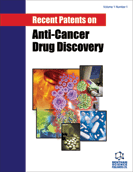
Abstract
Angiogenesis, the formation of new blood vessels from preexisting microvasculature, is a highly regulated process. Angiogenesis is controlled by both positive and negative factors thus providing several targets for drug discovery. The inhibition of angiogenesis represents a new approach to cancer therapy and several agents and approaches are in different stages of clinical development. These inhibitors were recently shown to constitute a new modality for cancer treatment. In this article, we will review angiogenesis inhibitors-related patent literature for the years 2000-2005. This review will cover specifically the discovery and development disclosures of endogenous inhibitors. The scope of this review is to give the reader a well-structured patent literature review of these agents targeting different steps of the angiogenic process. Finally, we have summarized the key attributes of the emerging endogenous angiogenesis inhibitors that make them potent antitumor agents.
Keywords: Angiogenesis, cancer, antiangiogenesis inhibitors, vascular target, angiostatin, endostatin, VEGF, receptor tyrosine kinase and kringle
Recent Patents on Anti-Cancer Drug Discovery
Title: Endogenous Angiogenesis Inhibitors as Therapeutic Agents: Historical Perspective and Future Direction
Volume: 1 Issue: 2
Author(s): Mohanraj Dhanabal and Natarajan Sethuraman
Affiliation:
Keywords: Angiogenesis, cancer, antiangiogenesis inhibitors, vascular target, angiostatin, endostatin, VEGF, receptor tyrosine kinase and kringle
Abstract: Angiogenesis, the formation of new blood vessels from preexisting microvasculature, is a highly regulated process. Angiogenesis is controlled by both positive and negative factors thus providing several targets for drug discovery. The inhibition of angiogenesis represents a new approach to cancer therapy and several agents and approaches are in different stages of clinical development. These inhibitors were recently shown to constitute a new modality for cancer treatment. In this article, we will review angiogenesis inhibitors-related patent literature for the years 2000-2005. This review will cover specifically the discovery and development disclosures of endogenous inhibitors. The scope of this review is to give the reader a well-structured patent literature review of these agents targeting different steps of the angiogenic process. Finally, we have summarized the key attributes of the emerging endogenous angiogenesis inhibitors that make them potent antitumor agents.
Export Options
About this article
Cite this article as:
Dhanabal Mohanraj and Sethuraman Natarajan, Endogenous Angiogenesis Inhibitors as Therapeutic Agents: Historical Perspective and Future Direction, Recent Patents on Anti-Cancer Drug Discovery 2006; 1 (2) . https://dx.doi.org/10.2174/157489206777442296
| DOI https://dx.doi.org/10.2174/157489206777442296 |
Print ISSN 1574-8928 |
| Publisher Name Bentham Science Publisher |
Online ISSN 2212-3970 |
 5
5
- Author Guidelines
- Graphical Abstracts
- Fabricating and Stating False Information
- Research Misconduct
- Post Publication Discussions and Corrections
- Publishing Ethics and Rectitude
- Increase Visibility of Your Article
- Archiving Policies
- Peer Review Workflow
- Order Your Article Before Print
- Promote Your Article
- Manuscript Transfer Facility
- Editorial Policies
- Allegations from Whistleblowers
Related Articles
-
Clinical Update: Treatment of Glioblastoma Multiforme with Radiolabeled Antibodies that Target Tumor Necrosis
Current Cancer Therapy Reviews An Automatic Glioma Segmentation System Using a Multilevel Attention Pyramid Scene Parsing Network
Current Medical Imaging Radiolabelled Oligonucleotides for Imaging of Gene Expression with PET
Current Medicinal Chemistry Aryl-isoquinoline as a Potential Scaffold for Novel Antitumor Agents against Glioblastoma Cells
Letters in Drug Design & Discovery RNAi in Clinical Studies
Current Medicinal Chemistry Tyrosine Kinase Inhibitors – A Review on Pharmacology, Metabolism and Side Effects
Current Drug Metabolism Plants vs. Cancer: A Review on Natural Phytochemicals in Preventing and Treating Cancers and Their Druggability
Anti-Cancer Agents in Medicinal Chemistry Polycistronic Viral Vectors
Current Gene Therapy Targeting the Akt/PI3K Signaling Pathway as a Potential Therapeutic Strategy for the Treatment of Pancreatic Cancer
Current Medicinal Chemistry The Return of the INGs, Histone Mark Sensors and Phospholipid Signaling Effectors
Current Drug Targets Cancer Stemness as a Target for Immunotherapy is Shaped by Proinflammatory Stress
Current Stem Cell Research & Therapy Edema-mass Ratio Based On Magnetic Resonance Imaging As A Preoperative Diagnostic Factor For Posterior Fossa Metastasis
Current Medical Imaging Neuroinflammation and Neuroprotection: An Update on (Future) Neurotrophin-Related Strategies in Multiple Sclerosis Treatment
Current Medicinal Chemistry Ex Vivo Gene Therapy and Vision
Current Gene Therapy Patent Selections
Recent Patents on Inflammation & Allergy Drug Discovery Role of the Bone Marrow Microenvironment in Drug Resistance of Hematological Malignances
Current Medicinal Chemistry Effect of PUFAs Oral Administration on the Amount of Apoptotic Caspases Enzymes in Gastric Cancer Patients Undergoing Chemotherapy
Anti-Cancer Agents in Medicinal Chemistry Recent Advances on Small Molecule Medicinal Chemistry to Treat Human Diseases
Current Topics in Medicinal Chemistry Nucleic Acids as Therapeutic Agents
Current Topics in Medicinal Chemistry Dendritic Cell Immunotherapy for Malignant Gliomas
Reviews on Recent Clinical Trials


























